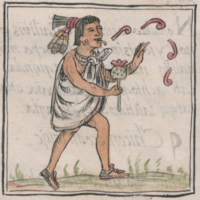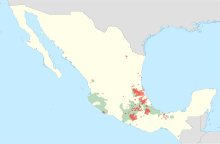
Back Nahuatl Afrikaans ናዋትል Amharic ناواتل Arabic ناواتل ARZ Idioma náhuatl AST Nawa aru Aymara Nahuatl dili Azerbaijani ناواتل دیلی AZB Nahuatl BCL Астэкскія мовы Byelorussian
| Nahuatl | |
|---|---|
| Aztec, Mexicano | |
| Nawatlahtolli, mexikatlahtolli,[1] mexkatl, mexikanoh, masewaltlahtol | |
 Nahua man from the Florentine Codex. The speech scrolls indicate speech or song. | |
| Native to | Mexico |
| Region | North America, Central America |
| Ethnicity | Nahuas |
Native speakers | 1.7 million in Mexico, smaller number of speakers among Nahua immigrant communities in the United States (2020 census)[2] |
Early form | |
| Dialects | |
| |
| Official status | |
Official language in | Mexico[3] |
| Regulated by | Instituto Nacional de Lenguas Indígenas[4] |
| Language codes | |
| ISO 639-2 | nah |
| ISO 639-3 | nhe |
| Glottolog | azte1234 Aztec |
 Current (red) and historical (green) geographic extent of Nahuatl. | |
Nahuatl (English: /ˈnɑːwɑːtəl/ NAH-wah-təl;[5] Nahuatl pronunciation: [ˈnaːwat͡ɬ] ⓘ),[cn 1] Aztec, or Mexicano[8] is a language or, by some definitions, a group of languages of the Uto-Aztecan language family. Varieties of Nahuatl are spoken by about 1.7 million Nahuas, most of whom live mainly in Central Mexico and have smaller populations in the United States.
Nahuatl has been spoken in central Mexico since at least the seventh century CE.[9] It was the language of the Mexica, who dominated what is now central Mexico during the Late Postclassic period of Mesoamerican history. During the centuries preceding the Spanish conquest of the Aztec Empire, the Aztecs had expanded to incorporate a large part of central Mexico. Their influence caused the variety of Nahuatl spoken by the residents of Tenochtitlan to become a prestige language in Mesoamerica.
Following the Spanish conquest, Spanish colonists and missionaries introduced the Latin script, and Nahuatl became a literary language. Many chronicles, grammars, works of poetry, administrative documents and codices were written in it during the 16th and 17th centuries.[10] This early literary language based on the Tenochtitlan variety has been labeled Classical Nahuatl. It is among the most studied and best-documented Indigenous languages of the Americas.[11]
Today, Nahuan languages are spoken in scattered communities, mostly in rural areas throughout central Mexico and along the coastline. A smaller number of speakers exists in immigrant communities in the United States.[12] There are considerable differences among varieties, and some are not mutually intelligible. Huasteca Nahuatl, with over one million speakers, is the most-spoken variety. All varieties have been subject to varying degrees of influence from Spanish. No modern Nahuan languages are identical to Classical Nahuatl, but those spoken in and around the Valley of Mexico are generally more closely related to it than those on the periphery.[13] Under Mexico's General Law of Linguistic Rights of the Indigenous Peoples, promulgated in 2003,[14] Nahuatl and the other 63 indigenous languages of Mexico are recognized as lenguas nacionales ('national languages') in the regions where they are spoken. They are given the same status as Spanish within their respective regions.[cn 2]
Nahuan languages exhibit a complex morphology, or system of word formation, characterized by polysynthesis and agglutination. This means that morphemes – words or fragments of words that each contain their own separate meaning – are often strung together to make longer complex words.
Through a very long period of development alongside other indigenous Mesoamerican languages, they have absorbed many influences, coming to form part of the Mesoamerican language area. Many words from Nahuatl were absorbed into Spanish and, from there, were diffused into hundreds of other languages in the region. Most of these loanwords denote things indigenous to central Mexico, which the Spanish heard mentioned for the first time by their Nahuatl names. English has also absorbed words of Nahuatl origin, including avocado, chayote, chili, chipotle, chocolate, atlatl, coyote, peyote, axolotl and tomato. These words have since been adopted into dozens of languages around the world.[15][16] The names of several countries, Mexico, Guatemala, and Nicaragua, derive from Nahuatl.[17][18][19]
- ^ "Mexikatlahtolli/Nawatlahtolli (náhuatl)". Secretaría de Cultura/Sistema de Información Cultural (in Spanish). Retrieved 20 June 2022.
- ^ Lenguas indígenas y hablantes de 3 años y más, 2020 INEGI. Censo de Población y Vivienda 2020.
- ^ "General Law of Linguistic Rights of Indigenous Peoples" (PDF) (in Spanish). Archived from the original (PDF) on 11 June 2008.
- ^ "Instituto Nacional de Lenguas Indígenas homepage".
- ^ Laurie Bauer, 2007, The Linguistics Student's Handbook, Edinburgh
- ^ Andrews 2003, pp. 578, 364, 398.
- ^ "Náhuatl" (in Spanish). rae.es. Retrieved 6 July 2012.
- ^ "Nahuatl Family". SIL Mexico. Retrieved 22 February 2021.
- ^ Suárez (1983:149)
- ^ Canger 1980, p. 13.
- ^ Canger 2002, p. 195.
- ^ "Introduction to Nahuatl". Center for Latin American Studies. Retrieved 2 April 2024.
- ^ Canger 1988.
- ^ "Ley General de Derechos Lingüísticos de los Pueblos Indígenas" (PDF). Diario Oficial de la Federación (in Spanish). Issued by the Cámara de Diputados del H. Congreso de la Unión. 13 March 2003. Archived from the original (PDF) on 11 June 2008..
- ^ Pint, John (11 November 2022). "The surprising number of Nahuatl words used in modern Mexican Spanish". Mexico News Daily. Retrieved 1 April 2024.
- ^ "Lesson Nine". babbel.com. Retrieved 1 April 2024.
- ^ Alex (23 March 2018). "Etymology of Country Names". Vivid Maps. Retrieved 7 June 2024.
- ^ "Etymology of Nicaragua".
- ^ "Nahuatl Dictionary Letter N".
Cite error: There are <ref group=cn> tags on this page, but the references will not show without a {{reflist|group=cn}} template (see the help page).